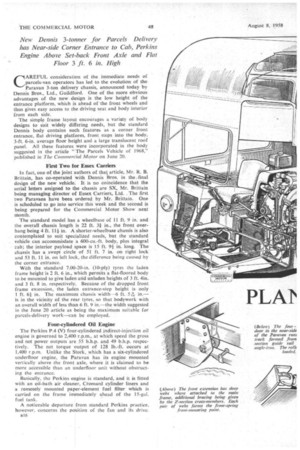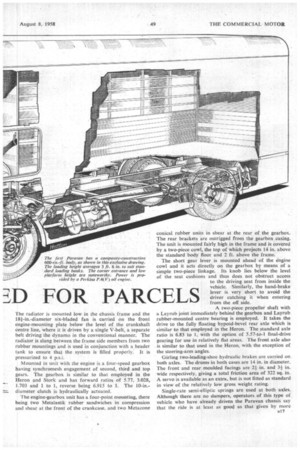PLAT' ED FOR PARCELS
Page 50

Page 51

Page 52

If you've noticed an error in this article please click here to report it so we can fix it.
CAREFUL consideration of the immediate needs of parcels-van operators has led to the evolution of the Paravan 3-ton delivery chassis, announced today by Dennis Bros., Ltd., Guildford. One of the more obvious advantages of the new design is the low height of the entrance platform, which is ahead of the front wheels and thus gives easy access to the driving seat and body interior from each side.
The simple frame layout encourages a variety of body designs to suit widely differing needs, but the standard Dennis body contains such features as a corner front entrance, flat driving platform, front steps into the body. 3-ft. 6-in, average floor height and a large translucent roof panel. AU these features were incorporated in the body suggested in the article "The Parcels Vehicle of 1968," published in The Commercial Motor on June 20.
First Two for Essex Carriers In fact, one of the joint authors of that article, Mr. R. B. Brittain, has co-operated with Dennis Bros. in the /final design of the new vehicle. It is no coincidence that the serial letters assigned to the chassis are SX, Mr. Brittain being managing director of Essex Carriers, Ltd. The first two Paravans have been ordered by Mr. Brittain. One is scheduled to go into service this week and the second is being prepared for the Commercial Motor Show next month.
The standard model has a wheelbase of 11 ft. 9 in. and the overall chassis length is 22 ft. 31 in., the front overhang being 4 ft. 111 in. A shorter-wheelbase chassis is also contemplated to suit specialized needs, but the standard vehicle can accommOdate a 600-cu.-ft. body, plus integral cab; the interior payload space is 15 ft. 91 in. long. The chassis has a swept circle of 51 ft. 7 in. on right lock and 53 ft. 11 in. on left lock, the difference being caused by the corner entrance.
With the standard 7.00-20-in. (10-ply) tyres the laden frame height is 2 ft. 6 in., which permits a flat-floored body to be mounted to give laden and unladen heights of 3 ft. 4in. and 3 ft. 8 in. respectively. Because of the dropped front frame extension, the laden entrance-step height is only . 1 ft. 61 in. The maximum chassis width-6 ft. 511; in.— is in the vicinity of the rear tyres, so that bodywork with an overall width of less than 6 ft. 9 in.—the width suggested in the June 20 article as being the maximum suitable for parcels-delivery work—can be employed.
Four-cylindered Oil Engine The Perkins P.4 (V) four-cylindered indirect-injection oil engine is governed to 2,400 r.p.m., at which speed the gross and net power outputs are 55 b.h.p. and 49 b.h.p. respectively. The net torque output of 128 lb.-ft, occurs at 1,400 r.p.rn. Unlike the Stork, which has a six-cylindered underfloor engine, the Paravan has its engine mounted vertically above the front axle, where it is claimed to be more accessible than an underfloor unit without obstructing the entrance.
Basically, the Perkins engine is standard, and it is fitted with an oil-bath air cleaner, Ctomard cylinder liners and a remotely mounted paper-element fuel filter which is carried on the frame immediately ahead of the 15-gal. fuel tank.
A noticeable departure from standard Perkins practice, however, concerns the position of the fan and its drive. The radiator is mounted low, in the chassis frame and the 18f-in.-diameter six-bladed fan is carried on the front engine-mounting plate below the level of the crankshaft centre line, where it is driven by a single V-belt, a separate belt driving the dynamo in the conventional manner. The radiator is slung between the frame side members from two rubber mountings and is used in conjunction with a header tank to ensure that the system is filled proPerly. It is pressurized to 4 psi.
Mounted in unit with the engine is a four-speed gearbox having synchromesh engagement of second, third and top gears. The gearbox is similar to that employed in the Heron and Stork and has forward ratios of 5.77, 3.028, 1.703 and 1 to 1, reverse being 6.915 to I. The 10-in.
diameter clutch is hydraulically actuated.
The engine-gearbox unit has a four-point mounting, there being two Metalastik rubber sandwiches in compression and shear at the front of the crankcase, and two Metacone
conical rubber units in shear at the rear of the gearbox. The rear brackets are outrigged from the gearbox casing. The unit is mounted fairly high in the frame and is covered by a two-piece cowl, the top of which projects 14 in. above the standard body floor and 2 ft. above the frame.
The short gear lever is mounted ahead of the engine cowl and it acts directly on the gearbox by means of a simple two-piece linkage. Its knob lies below the level of the seat cushions and thus does not obstruct access to the driving seat from inside the vehicle. Similarly, the hand-brake lever is very short to avoid the driver catching it when entering from the off side.
A two-piece propeller shaft with a Layrub joint immediately behind the gearbox and Layrub rubber-mounted centre bearing is employed. It takes the drive to the fully floating hypoid-bevel rear axle which is similar to that employed in the Heron. The standard axle ratio is 6.83 to 1, with the option of 5.57-to-1 final-drive gearing for use in relatively flat areas. The front axle also is similar to that used in the Heron, with the exception of the steering-arm angles.
Girling two-leading-shoe hydraulic brakes are carried on both axles. The drums in both cases are 14 in. in diameter. The front and rear moulded facings are 2-+ in. and 3+ in. wide respectively, giving a total friction area of 322 sq. in. A servo is available as an extra, but is not fitted as standard in view of the relatively low gross weight rating.
Single-rate semi-elliptic springs are used at both axles. Although there are no dampers, operators of this type of vehicle who have already driven the Paravan chassis say that the ride is at least as good as that given by more
complicated suspension systems. Burman worm-and-peg steering with a free-standing column is fitted, and the steering gear ratio is 27 to 1.
The drop arm is to the right of the steering box, but it is cranked sharply, so that it passes under the box. In this way it has been possible to mount the column well over to the off side of the chassis without the drag link interfering with the steering, lock.
Fitted bolts are used throughout the assembly of the frame, which has a simple layout despite its specialized application. The main side members, which are of manganese steel, are -1-4 in. thick and have a constant depth of 6. in., the flanges being 21 in. wide. The side members are flat and parallel throughout and extend 2 ft. 3!T in. ahead of the front-axle centre line. Bolted to the front of the members is an extension, consisting of two channelsection wOded fabrications, cranked so that their upper edges lie I ft. 2 in. below the upper flanges of the frame.
The frame width is 2 ft.. 614,, in. and bracing is provided by three top-hat section, one banjo-channel, one Z-section and one boxed top-hat-section cross-members. The banjochannel provides the mounting point for the rear of the engine-gearbox unit, whilst the Z member braces the front of the chassis where the extension joins the main members. A flat plate, bolted to angles, forms the mounting member for the front of the engine.
Bodies up to 650 cu. ft.
The chassis is rated for a payload of approximately 3 tons. The recommended gross weight is 5 tons 16 cwt., with a front-axle limitation of 1 ton 19 cwt. Although the standard body built by Dennis Bros. has a capacity of 600 Cu. ft., the chassis is suitable for bodies of up to 650 Cu. ft. capacity, subject to the recommended gross weight not being exceeded. The kerb weight of the chassis only, complete with 12-v. batteries and spare wheel, is approximately 1 ton 18 cwt.
Two types of body are to be offered by Dennis, both having the same general shape and differing only in respect of the material used. Both are based on timber frames, but the first one to be taken over by Essex Carriers, Ltd., will have Plynnax metal-faced plywood panels, whilst the second van, which is to be shown at Earls Court in partly sectioned form, will have flat plastics panels, colourimpregnated in the Essex Carriers livery.
The general design of the body, which includes the cab, is reasonably straightforward. The sides are flat to a point ahead of the front axle, and the timber floor has no wheel
boxes when used in its parcels-van application, because of the standardized loading-bank height of 3 ft. 6 in. The rear of the body is closed by a timber-slatted roller shutter and 2-ft. tailboard, whilst the roof in both versions incorporates a 14-ft. by 3-ft. translucent plastics panel.
It is intended that the rear of the. vehicle should be used only when. loading at the depot and that deliveries should be made from the front of the vehicle, thus relieving the driver of the responsibility of locking the shutter and tailboard each time •a delivery is made.
For this reason a 2-ft. 8-in.-wide corner entrance has been chosen, this lying at an angle of 45', so that the driver can enter or leave the vehicle either thrciugh the side or the front. The door, which is 6 ft. 3 in. wide, is in four sections, the centre two of which are glazed. These sections run in a roller track and lift upwards, so that, when fully raised they lie across the vehicle under the cab roof and thus form no obstruction to the entrance.
Three Step3 to Goods Platform The first step to the platform is 1 ft. 6f in. above the ground and is rather shallow; the driving platform is 4+ in. above it and extends across most of the width of the front of the vehicle. Behind the main platform there is a third step 12 in. higher which extends across the front of the engine cowl up to the near-side body panel and forms an intermediate step up to the main body. floor; 10 in. higher.
In the vans supplied to Mr. Brittain a partition and sliding door are being fitted behind the engine cowl, this partition giving an opening of 2 ft. 10 in. in the near side of the body, which reduces to 2 ft. alongside the engine cowl. A forward-hinge'd door is provided in the off side of the body ahead of the front wheel and has a: drop window. Behind both doors the body side is glazed as far back as the partition to give the driver increased side vision. The one-piece flat windscreen has a single wiper and only one headlight is fitted. Two lights are installed in the van body and a fully equipped instrument panel is clamped to the steering column.
The Paravan with standard body has an overall length of 22 ft. 7 in. and the maximum width of 6 ft. 9 in. includes side rubbing rails. The approximate laden height is 10 ft., whilst the interior height on the centre line is 6 ft. 6 in. The interior body length is 15 ft. 91 in. behind the partition. The rear aperture is 5 ft. 7 in. high and 5 ft. 9 in. wide, and 2-ft.-high tongued-and-grooved boarding is provided, down the inside of the body, above which there are six evenly spaced aluminium slats to afford further protection.




































































































